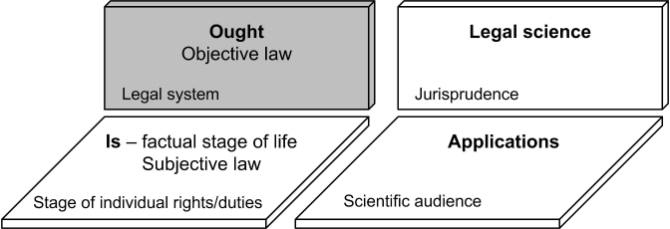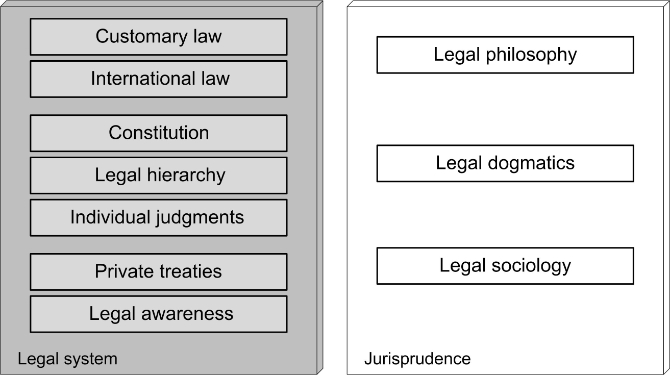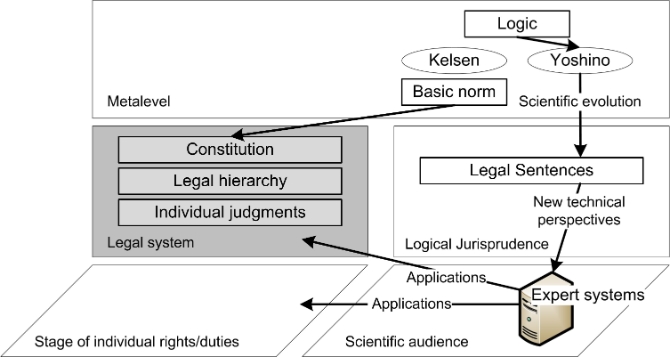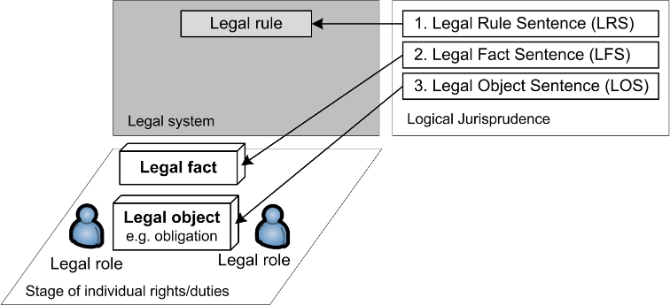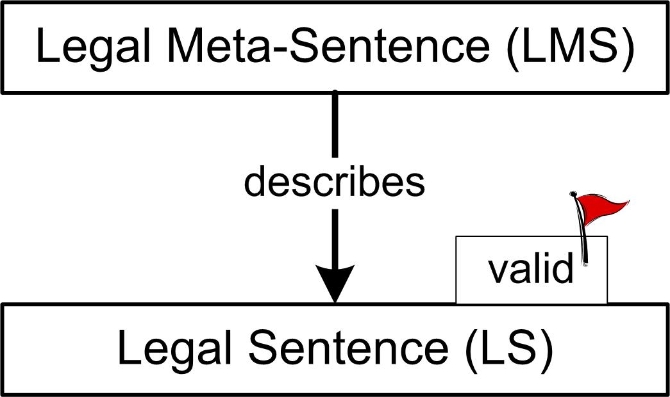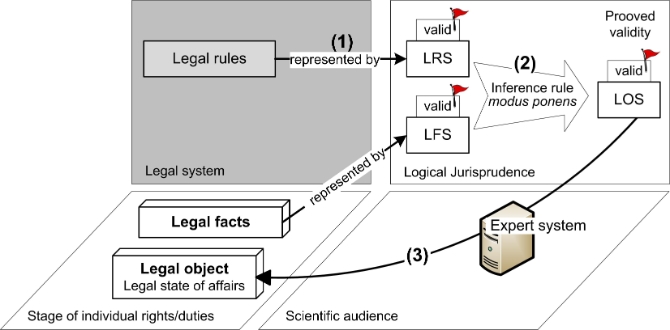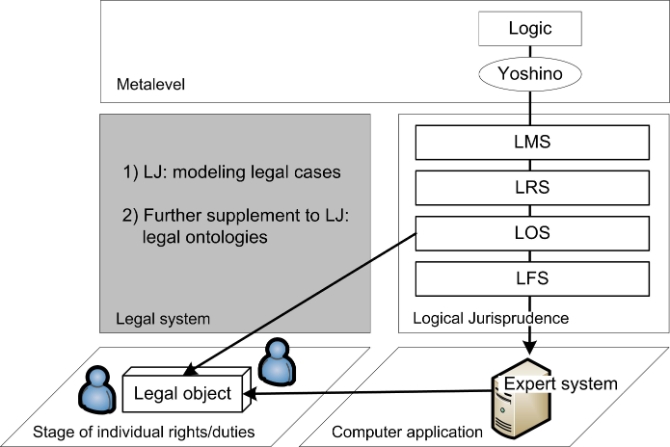1.
Introduction ^
2.
Introducing Yoshino’s Logical Jurisprudence ^
Kelsen’s Basic Norm appears on the meta-level (Figure 4). The constitution, laws, statutes and individual decisions form a hierarchy; see [Kelsen 1967], part V, especially § 35. Kelsen speaks about a hierarchical structure of norms: [W]hose highest level is the constitution whose validity is founded on the presupposed Basic Norm, and whose lowest level is made of the individual norms decreeing particular concrete behavior to be obligatory. [Kelsen 1991, 258]
3.
Logical Jurisprudence ^
3.1.
Legal Sentences ^
- Legal rule sentences (LRS) and legal fact sentences (LFS)
- Legal elementary sentences and legal complex sentences
- Legal object sentences (LOS) and legal meta-sentences (LMS)
We see that LS serves as a description and can be treated as a string. Validity, i.e. a truth value, is concerned with legal meta-sentences. We treat LRSs, LFSs and LOSs as being in is-a relation with LSs (Figure 6 b). In the same way, LMRSs, LMFSs and LMOSs are in is-a relation with LMSs (see below). Strict categorizations are demanded in computing. However, black-and-white formalizations may not be appropriate in the legal domain. Therefore grey zones exist: there is an open texture. However, theories should aim at conceptual purity.
CISG1 Article 15(1): An offer becomes effective when it reaches the offeree.
become_effective( offer(X,A), T ) :- reach( offer(X,A), offeree(B,X), T)
A’s offer reaches offeree B on April 5.
3.2.
Three Primitives: Legal Sentence, Validity and Inference Rule ^
- Legal sentence. Logical Jurisprudence considers that norm as a meaning (Sinn) in Ought does not exist. Thus, LJ starts from sentences.
- Validity of legal sentences.
- Inference rule. The modus ponens rule is used: P→Q, P |– Q. This is used for deduction from valid (in the sense of LJ) legal sentences.
‘It is obligatory for A to deliver the goods to B’ is valid on 2010-05-01.
3.2.1.
Connections of Legal Sentences ^
- ‘and’ (&)
- Connection into a legal complex sentence (LCS)
- Connection between LOS and LMS
- Connection between LMS and LMS
3.2.1.1.
Connector ‘and’ ^
3.2.1.2.
Connection into a Legal Complex Sentence ^
3.2.1.3.
Connection between Legal Object Sentence (LOS) and Legal Meta-Sentence (LMS) ^
r3aa2: If A has a right to require B to do Z at time T and A requires B to do Z at T,
then a legal sentence «It is obligatory for B to do Z» becomes valid at T.
The above rule asserts that a duty which is represented by a legal object sentence follows from a rule which represents the right. Yoshino (2012) analyses the concept of right in terms of legal meta-sentences. He aims to contribute to the «dynamic systematization of law.»4
3.2.1.4.
Connection between LMS and LMS ^
CISG Article 1 (1): This Convention applies to contracts of the sale of goods between parties whose places of business are in different states: (a) when states are contracting states; or …
CISG Article 23: A contract is concluded when an acceptance of an offer becomes effective.
3.2.2.
Legal Inference ^
Legal sentences are developed through the process of legal reasoning. Yoshino (2011b, 27–28) concentrates on two types of legal reasoning:
- Reasoning of legal justification. This is based on deduction through modus ponens.
- Reasoning of legal creation (or discovery). This is further divided into two parts:
- abduction. The inference rule modus tollens is applied;
- induction.
- Concretization. Statutory terms are made tangible by creating LRSs which describe inclusion relations.
- Systematization. The sentences of legal principles are created and these enable us to bring mere collections of LSs into a unified, coherent deductive system.
3.3.
Fundamental Legal Meta-Rule Sentence (FLMRS) ^
r0: A legal sentence is valid at time T, if and only if a legal sentence becomes valid before T and it is not the case that the sentence is terminated before T.
A legal sentence S is valid at the time T ⇔
( S becomes valid at time T1 before T ) & // First requirement
not ( S is terminated after T1 and before T ) // Second requirement
3.4.
Legal Meta-Rule Sentence (BLMRS) ^
4.
Comparison of Yoshino’s LJ with Kelsen’s PTL ^
5.
Conclusions ^
6.
References ^
Casellas, Núria, Legal Ontology Engineering, 3 Law, Governance and Technology Series, Springer, Dordrecht 2011.
Kelsen, Hans, Pure Theory of Law, 2nd ed., M. Knight (trans.) (Reine Rechtslehre, 2. Auflage. Deuticke, Wien, 1960), University of California Press, Berkeley 1967.
Kelsen, Hans, General Theory of Norms, M. Hartney (trans.) (Allgemeine Theorie der Normen, Wien: Manz Verlag, 1979), Clarendon Press, Oxford 1991.
Leith, Philip (2010) The rise and fall of the legal expert system, European Journal of Law and Technology, volume 1, issue 1, 2010. http://ejlt.org//article/view/14 (accessed on 2 January 2017).
Pufendorf, Samuel, De jure naturae et gentium, 1672, English trans. C. H. Oldfather and W. A. Oldfather, Oceana, New York 1964.
Sergot M. J., Sadri F., Kowalski R. A., Kriwaczek F., Hammond P., Cory H. T. (1986) The British Nationality Act as a logic program. Communications of the ACM, volume 29, issue 5, 1986, p. 370–386.
Tsuno, Guido, Repertorium Aureum, Rechtslexika im Geltungsbereich des Ius Commune und im 19. Jahrhundert. Vico Verlag, Frankfurt am Main 2011.
Yoshino, Hajime, The Systematization of Legal Meta-inference. In: Proceedings of the Fifth International Conference on Artificial Intelligence and Law, ICAIL '95, ACM, New York 1995, pp. 266–275.
Yoshino, Hajime, The Systematization of Law in Terms of the Validity. In: Proceedings of the Thirteenth International Conference on Artificial Intelligence and Law, ICAIL '11, ACM, New York 2011a, pp. 121–125.
Yoshino, Hajime, The Fundamental Concepts of Law Enabling the Systematization of Law. In: Yoshino, Hajime/Araszkiewicz, Michal/Walker, Vern R. (Eds.), Proceedings of the Fundamental Concepts and the Systematization of Law (FCASL), Workshop at JURIX 2011 in Vienna, 2011b, pp. 24–32.
Yoshino, Hajime, The Logical Analysis of the Concept of a Right in Terms of Legal Meta-sentences. In: Schweighofer, Erich/Kummer, Franz/Hötzendorfer, Franz (Eds.), Transformation of Legal Languages, Proceedings of the 15th International Legal Informatics Symposium IRIS 2012, OCG, Vienna 2012, pp. 305–312.
- 1 The United Nations Convention on Contracts for the International Sale of Goods.
- 2 Yoshino writes: «[L]egal rules must be applicable to the case. In other words, legal rules must be valid to solve the problem of the case. […] That a legal sentence is valid means that it is true in the legal discourse of the world. […] If a legal sentence which describes a legal state of affairs is valid, it means that the legal state of affairs exists in the legal world.» [Yoshino 2011a, 122]
- 3 Yoshino writes: «A legal meta-rule sentence, which is applied to prove that a legal meta-sentence is valid, must also be valid. […] This can be done through the deduction from a legal meta-fact sentence declaring that the legal meta-rule sentence is valid or by the application of other legal meta-rule sentences. Therefore it is most important for the systematization of law to confirm legal meta-fact and rule sentences which make such deduction possible.» [Yoshino 2011a, 122]
- 4 Yoshino writes: «[T]he Hohfeldian logical formalization […] fails to adequately systematize the dynamic changes of rights and duties in relation to changes in time. In contrast, we propose a system of analysis that recognizes the inherent hierarchy between a right on the meta-level and a duty on the object level language.» [Yoshino 2012, 305]
